
A map of the Granada camp. |
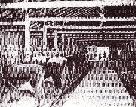
Raising cattle on the camp. |

Akira Sameshima, student body president, presenting athletic awards. |

High school assembly showing flag-raising ceremony., 05/23/1943 |

High school students at outdoor assembly., 05/23/1943 |

High school girl's glee club., 05/23/1943 |

View of evacuee children playing., 05/23/1943 |

Harvesting the first spinach from the project farm., 06/04/1943 |

Fourth grade children weeding their victory garden., 06/04/1943 |

A scene from the Boy Scout Memorial Day Parade, which was held at this center on May 30. |

Blue Star Mothers and wives and visiting soldiers., 06/26/1943 |

Amache Community Council., 06/28/1943 |

Miss Marion Konishi, who made the commencement speech at the Granada Relocation Center High School. |

Flood damage to G Street., 07/09/1943 |

Flood damage to G Street., 07/09/1943 < |

Community store under construction damaged by storm., 07/09/1943 |

Block 11E showing course of flood water., 07/09/1943 |

9E Block after flood., 07/09/1943 |

Amache Summer Carnival Parade., 07/10/1943 |

Amache High School model airplane display., 08/1943 |

Evacuees from Tule Lake being loaded on trucks to be transported to Amache from the Granada railway station. |

Woodcarving exhibited at the Amache Agricultural Fair, held September 11 and 12. |
 Part of the approximately 1,000 dancers who participated in the Bon Odori festival sponsored by the Granada Buddhist Church on August 14. Spectators are shown in the background. This dance was held at night on the baseball diamond. |

Mary Okidoi participating in the Bon Odori dances, August 14, sponsored by the Granada Buddhist Church. |

Two Issei who joined the Bon Odori dance, August 14, which was sponsored by the Granada Buddhist Church |
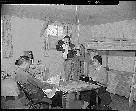 The Ninomiya family in their barracks room at the Amache Center. The mother's handiwork in preparing drapes, fashioning furniture out of scrap material, plus the boys' ingenuity in preparing double deck bunks have made this bare brick floored barracks room a fairly comfortable duration home. Tosh Ninomiya left, is charged with the responsibility of documenting the history of the Amache Center. |
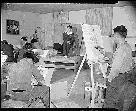
An adult art class under the direction of Tokio Ueyama, working in pencil sketch charcoals and oils. Adult art classes are extremely popular at the Amache Center. |
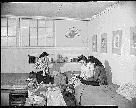 Sunday afternoon and the three girls who occupy this barracks room relax. The furniture, the book niche, flower pot and print mats are all made by the girls from scrap lumber and scrap pieces of wall board. |
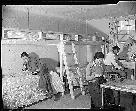
The Ninomiya family in their barracks room at the Amache Center. The mother's handiwork in preparing drapes, fashioning furniture out of scrap material, plus the boys' ingenuity in preparing double deck bunks have made this bare brick floored barracks room a fairly comfortable duration home. Tosh Ninomiya, left, is charged with the responsibility of documenting the history of the Amache Center. |
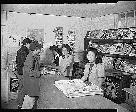
The magazine counter at one of the cooperative stores in the Amache Relocation Center. |
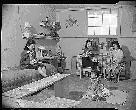
Two adult women and a small girl occupy this barracks room at the Amache Center. All the furniture, shelves and the dressing table were made by the girls from scrap lumber picked up from the contractor's scrap pile. |
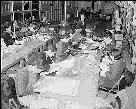
An adult education class in fine needlework. The teacher, Mrs. A. Okuda. |
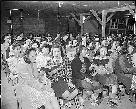
A choral group of 200 volunteer voices practicing for a Christmas Carol and program. The group will, on Christmas Eve, divide into four sections. Each section will assemble at the four corners of the center and slowly converge, singing carols, toward a central point. A Christmas Eve party of community singing will be held. |
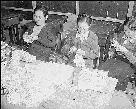
Three members of an adult crocheting class. The instructor (center) teaches students to crochet everything from doilies to lapel trinkets and flower pot covers. |
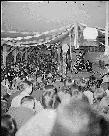
Two Nisei girls perform on native Japanese musical instruments during a talent show in one of the block mess halls. |
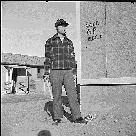
Volunteer civilian police, such as this patrolman, guard the safety and home security of center residents 24 hours a day. His mark of office is the typical police club and the blue and white arm band carrying the letters P.D. |
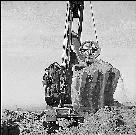
Among the 8000 residents at this center, there wasn't a single man who had ever run a steam shovel, but volunteers for the job were many. Two of those selected are acting as oilers as they learn the technique of swinging the big shovel. |
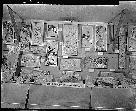
The woodcarvings on this exhibit panel at the Arts and Crafts Festival, were made by students in adult education classes. This Festival was held March 6th to 8th in Terry Hall at the center, and was sponsored by the Education Division and the "Pioneer," the Granada Relocation Center newspaper |
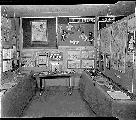
An exhibit prepared by the Elementary School for the Arts and Crafts Festival which was sponsored by the Education Division and the "Pioneer," the center newspaper. |
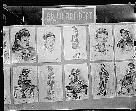
Charcoal sketches drawn by art students in the Senior High School art class for the Arts and Crafts Festival. The center newspaper, the "Pioneer," and the Education Division sponsored this center festival. |
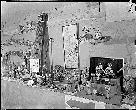
A miscellaneous assortment of items on display at the Arts and Crafts Festival held at Terry Hall at the Granada Center. Note the hanging basket with flower arrangement on the wall (right) and the Japanese musical instruments and wood carvings (left). |
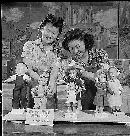
Girls' Reserves Victory Dolls. Jane Nagai, left, and Boots Sotomura, right. Each doll was dressed by a Girl Reserve froup in the Granada Center. They represent various womens' war-work activities, and were on display at the Arts and Crafts Festival March 6th to 8th. |
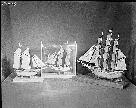
Ship models made by Issei patient at Amache Hospital., 09/14/1945 |
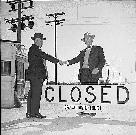
Shuichi Yamamoto, last Amache evacuee to leave the Granada Project Relocation Center, says "Goodbye" to Project Director James G. Lindley, as War Relocation Authority camp is officially closed October 15, 1945. Mr. Yamamoto, 65 years of age, is returning to his former home in Marysville, California. |
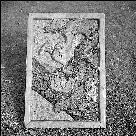 "Mother Hawk and Fledglings in Pine Tree Nest" - Woodcarving. Granada War Relocation Authority Project, Amache, Colorado. October 8, 1945. |
 View of little pigs on project hog farm. 5/29/43 |
 Memorial to those Nisei from the camp who were killed while fighting in the U.S. military. |

Granite monument erected in memory of the center residents who died in the War Relocation Camp at Amache, Colorado, was dedicated on Sept. 6, 1945, in an outdoor ceremony at the cemetery. The monument was designed by Reverend Masahiko Wada. Names of 148 persons, including 31 Nisei who died in the service of their country, are inscribed on the stone. A total of nearly 15,000 evacuees were inducted into the Granada Project, Amache, Colorado, since August 27, 1942, when the first group arrived from the Merced Assembly Center to prepare the camp for those to follow. The Relocation Center, as its name implies, was a temporary residence for those of Japanese ancestry who were transferred from their homes along the west coast under a war emergency measure of 1942. Many of the evacuees during the past three years were able to resettle and find new homes in the Middle West and eastern states. From September 1, 1945, to the closing date of October 15, 3,105 persons have gone back to their former homes or have relocated elsewhere. The last to leave the center, a group of 126, left on two special coaches for Sacramento and nearby towns. At the peak of its population, Amache had 7,567 residents. 412 births were recorded and 107 deaths during the three years of its existence. |
 View of evacuee children playing. 5/23/43 |
 Picture of this center's air-raid alert, which took place May 23. 5/23/43 |
 Fourth grade girl--Diane Wallace--weeding the school victory garden. 6/4/43 |
 Evacuee barracks showing gardens and trees . 6/20/43 |
 Amache Community Council. 6/28/43 |
 G Street damage at 10th Street. 7/9/43 |
 Amache Summer Carnival parade. 7/10/43 |
 Welcome Tuleans sign. 9/22/43 |
 The train of Tule Lake evacuees as it arrived in Granada. 9/15/43 |
 Loading Tule Lake-bound evacuees from Granada Relocation Center. 9/16/43 |
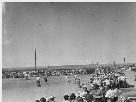 Part of the crowd of 2,000 people, evacuees and outsiders, who witnessed a baseball game Sunday, September 12, 1943, between the Prowers County all-star team and an Amache team. The Amache team won, 20-9. 9/12/43 |
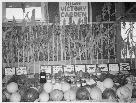 The Junior High School Victory Garden display at the Amache Agricultural Fair, September 11 and 12. 9/11/43 |
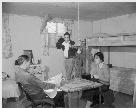 The Ninomiya family in their barracks room at the Amache Center. The mother's handiwork is preparing drapes, fashionable furniture out of scrap material, plus the boys' ingenuity in preparing double bunk beds have made this bare brick floored barracks room a fairly comfortable duration home. Tosh Ninomiya, left, is charged with the responsibility of documenting the history of the Amache Center. 12/9/42 |
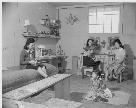 Two adult women and a small girl occupy this barracks room at the Amache Center. All the furniture, shelves and the dressing table were made by the girls from scrap lumber picked up from the contractors' scrap pile. |
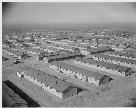 Overlooking the Amache Relocation Center, near Granada, Colorado. In the foreground is a typical barracks unit consisting of 12 six room apartment barracks buildings, a recreation hall, laundry and bathrooms, and the mess hall. 12/9/42 |
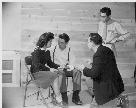 Drama instructor, Derlan, coaches three drama students in preparing for the presentation of 3 one act plays, as the first presentation of their adult education Little Theatre Group. 12/10/42 |
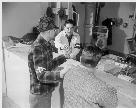 A patrolman of the resident police staff brings in a culprit and turns over suspected stolen contraband to the desk sergeant. During the first three months of the center, only two cases of petty theft were on the desk sergeant's blotter. 12/12/42 |
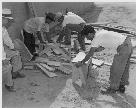 Early arrivals preparing benches and make shift seats to provide temporary furniture in their barracks. Former residence: Merced Assembly Center, Merced, California. 8/29/42 |
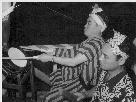 Although music for the Bon Odori held August 14 was furnished by phonograph records and a loud speaker, it was supplemented by the two drummers shown. They are, left to right, Keshiro Kumagai and Jutaro Gondo. The Bon Odori was sponsored by the Granada Buddhist Church. 8/14/43 |
 Sergeant Fred H. Odanaka, only Japanese-American member of the special Army recruiting team sent to the Granada Relocation Center to enlist the volunteers in a Japanese-American Combat Unit, here explains details of Army questionnaires which are being completed by all Japanese and Japanese-Americans between the ages of 18 and 38, now residing in relocation centers after evacuation from west coast areas. Joe Nakamura, a former 18 year old farmer from Yuba City, California, is about to answer the two vital questions of the questionnaire. Do you want to fight in the Army of the United States?'' and Do you swear allegiance to this country? 2/10/43 |
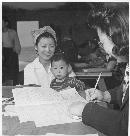 With her son, young Dennis, in her arms, Mrs. T. Sasabushi, Nisei resident at the Granada center, registers for defense employment in the general registration of all evacuated west coast Japanese and Japanese-Americans being carried on for the Army and the War Relocation Authority. Miss Judy Yasaki of the Center Education Department is the interviewer. From the left to right: Mrs. T. Sasabushi and son Dennis; Miss Judy Yasaki, interviewer. |
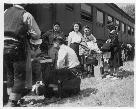 First evacuee arrivals at Granada assemble alongside the train awaiting bus transportation to the relocation center which is located some 2-1/2 miles away. These evacuees are from Merced Assembly Center, Merced, Calif. |
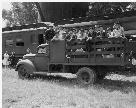 A truck load of young evacuees leaving the Granada railroad station bound for the relocation center 2-1/2 miles away. These evacuees were formerly from Merced Assembly Center, Merced, Calif. 8/24/42 |
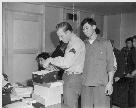 An Army sergeant finger prints Howard Uno, a loyal Nisei, who has been recruited in the United States Army. Howard will leave his wife and baby at the center, probably for the duration at the Amache Relocation Center. 12/12/42 |
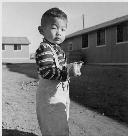 It is a long time between meals at the mess hall for a hungry man, so the cracker box at the Kobayashi barracks gets a frequent raiding. |
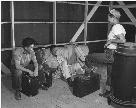 Three young evacuees drop their baggage and relax to argue about whose bunk goes in which corner on arriving at their new quarters. |
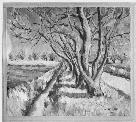 Oil painting of Irrigation Ditch and section of Project Farm. Granada Relocation Center, Amache, Colorado. February 15, 1945. 10/15/45 |
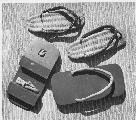 Zori (straw sandals) and Geta (wooden clogs) made at Granada WRA Project. 10/15/45 |
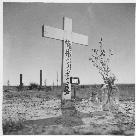 Not all the center residents will return to their former homes. Many have found permanent relocation in the sandy soil on which the tar paper barracks were hurriedly erected. A total of nearly 15,000 evacuees were inducted into the Granada Project, Amache, Colorado, since August 27, 1942, when the first group arrived from the Merced Assembly Center to prepare the camp for those to follow. The Relocation Center, as its name implies, was a temporary residence for those of Japanese ancestry who were transferred from their homes along the West Coast under an emergency measure of 1942. Many of the evacuees during the past three years were able to resettle and find new homes in the middle west and eastern states. From September 1, 1945 to the closing date October 15, 3,105 persons have gone back to their former homes or have relocated elsewhere. The last to leave the center, a group of 126, left on two special coaches for Sacramento and nearby towns. At the peak of its population, Amache had 7,567 residents. 412 births were recorded and 107 deaths during the three years of its existence. |
 Sergeant Robert I. Bischoff, a member of a special recruiting detail, sent to the Granada Relocation Center, where persons of Japanese ancestry evacuated from west coast defense areas are residing, explains two pertinent questions in an army recruiting form to Mineow Hanada, 22, a former resident of Colusa, California. Hanada's answer to voluntary enlistment in the special combat unit for Japanese-Americans was typical of many young Nisei at the Granada Center: I want to fight for the United States, but not in a special Japanese-American Unit. I want to be with other Americans in regular units. If I am drafted I will go willingly. 2/10/43 |
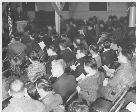 A block group of Japanese and Japanese-Americans, residents at the Granada Relocation Center, listen to an explanation of the army questionnaires which give young men between the ages of 18 and 38 an opportunity to join the Army of the United States in a special combat unit, composed of Japanese-Americans, and will pave the way for other men and women to leave the center for defense work. Captain William S. Fairchild, a member of the special army team sent to the center for the purpose, explains the questionnaire blanks and the purpose to residents in special meetings of block groups. 2/9/43 |
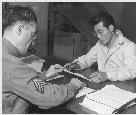 Sergeant George T. Davis, a member of the special recruiting team sent to the Granada Relocation Center to recruit volunteers for the Japanese-American combat unit in the regular Army of the United States, hands a questionnaire blank to a former resident of Yuba city, California, in an impromptu recruiting office at the center. Average young Niseis expressed desire to fight in the Army of the United States, but demurred at joining the special combat unit. They wanted to be with other Americans in regular units. |
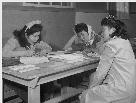 Mary Oki, a member of the Center Education Department, assisting in registering two young Nisei residents, Edith Yoshimoto (left), and Mary Yasuda (right), in the general registration instigated by the United States Army and the War Relocation Authority. All residents were being registered as a first step in utilizing the available manpower in war work. Mary and Edith were interested in defense work, but more interested in the possibility of serving in the military auxiliary armed forces. 1/12/43 |
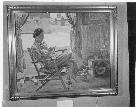 This portrait painting was made at the Santa Anita Assembly Center by Tokio Ueyama, head of the art studio at the Granada Center, and displayed at the Arts and Crafts Exhibit, sponsored by the Education Division and the Pioneer, center newspaper, at Terry Hall. 3/6/43 |
 View showing Elementary children landscaping the grounds in front of their barracks school. 4/24/43 |
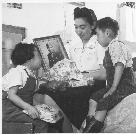 Little Peggy and Bobby Miyake won't have a Christmas tree in their barracks room home at the Granada Relocation Center. There just weren't any trees. But Christmas is still Santa Claus to them, as mother unwraps early gifts, among them, a picture of their father, Bill Miyaki [Miyake?], who is a soldier in the Army of the United States. The family was evacuated from the west coast along with all other persons of Japanese ancestry. 12/24/43 |
 Flying Tiger made of yarn with pine needles of silk thread by Mrs. Kotono Kato. 9/14/45 |
 Ship models made by Issei patient at Amache hospital. 9/14/45 |
Construction of the camp began on June 12, 1942. It was in operation by the end of August and held a maximum population of 7,318 by October. It was the smallest of the ten relocation centers. It closed officially on October 15, 1945. Not much of the original structure remains.
From the Final Report: Japanese Evacuation on the West Coast 1942, dated June 5, 1943, a description of the site:"The Granada Relocation Project site is one and one-half miles west of Granada, Colorado, and fourteen miles east of Lamar. It comprises approximately 10,500 acres of land and extends into the State of Kansas. Most of thearea was formerly known as the X-Y Ranch. Water stock in the amount of 15,000 shares of the Lamar Canal and Irrigation Company and 127 shares ofthe X-Y Irrigation Ditch Company were purchased to provide water needs for the agricultural program. Several thousand acress of this area were formerly owned by the American Sugar Beet Co."